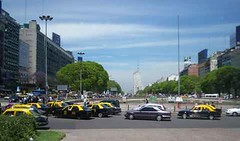
Avenida 9 de julho e táxis / 9th july avenue and taxis
Originally uploaded by r0drig0 FL0res.
Avenida 9 de julho e os famosos táxis argentinos / 9th july avenue and its famous taxis.
Neste espaço eu escrevo sobre minhas viagens, passeios e aventuras. Aproveite! I describe in this blog my adventures and trips. Have fun!

Avenida 9 de julho e os famosos táxis argentinos / 9th july avenue and its famous taxis.
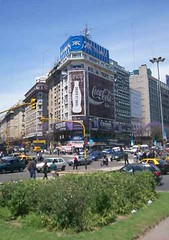
Outro ponto da Avenida 9 de julho, em Buenos Aires, Argentina / Another place of the 9th july Avenue, in Buenos Aires, Argentina.
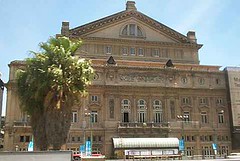
Famoso Teatro Colón, em Buenos Aires. A fachada está em reformas, foi a melhor foto que pude tirar, considerando que eu estava dentro do ônibus / Famous Colón Theater, in Buenos Aires. Facade is in reform. It was the best pic I could shot, since I was inside the bus.

Foto que tirei ainda no ônibus na chegada a Buenos Aires, estamos ainda na Avenida 9 de julho / I took this shot in bus arriving in Buenos Aires. We are still on the 9 th july avenue.

Os inconfundíveis táxis na Avenida 9 de julho, em Buenos Aires. / The famous argentinean taxis on 9th Avenue in Buenos Aires.
 Cidade de Zarate, após horas em trânsito pelo deserto, digo, pelo pampa, a vista desta cidade é como um oásis no meio do deserto. Zarate faz parte da região metropolitana de Buenos Aires. / City of Zarate after hours travelling in the "pampa" this sight is just like a oasis in the desert. Zarate is part of the metropolitan area of Buenos Aires.
Cidade de Zarate, após horas em trânsito pelo deserto, digo, pelo pampa, a vista desta cidade é como um oásis no meio do deserto. Zarate faz parte da região metropolitana de Buenos Aires. / City of Zarate after hours travelling in the "pampa" this sight is just like a oasis in the desert. Zarate is part of the metropolitan area of Buenos Aires.
 Há poucas testemunhas da civilização humana em meio do deserto verde e amarelo da Província de Entre Rios, nordeste da Argentina, com exceção das torres de alta tensão que acompanham a estrada. No mais, viaja-se por horas num terreno plano sem nada de interessante para ver / There´s a few testimonies of human civilization in the middle of the green and yellow desert in the Entre Rios Province, Northeast of Argentina, exception the electricity towers beside the road. It´s possible to drive for hours without see anything interesting.
Há poucas testemunhas da civilização humana em meio do deserto verde e amarelo da Província de Entre Rios, nordeste da Argentina, com exceção das torres de alta tensão que acompanham a estrada. No mais, viaja-se por horas num terreno plano sem nada de interessante para ver / There´s a few testimonies of human civilization in the middle of the green and yellow desert in the Entre Rios Province, Northeast of Argentina, exception the electricity towers beside the road. It´s possible to drive for hours without see anything interesting.  Outra foto da alfândega de Paysandu, fronteira com a Argentina. Este Fiat vermelho é muito legal. Minha cara não está muito boa, por causa da hora da manhã e também por que tinha viajado a noite toda. Não reparem o moletom amassado! / Another shot from Uruguay´s custom in city of Paysandu, in the Argentina borderline. This old red Fiat looks very nice! My face doesn´t look good, since it´s early in the morning and I travel all the night.
Outra foto da alfândega de Paysandu, fronteira com a Argentina. Este Fiat vermelho é muito legal. Minha cara não está muito boa, por causa da hora da manhã e também por que tinha viajado a noite toda. Não reparem o moletom amassado! / Another shot from Uruguay´s custom in city of Paysandu, in the Argentina borderline. This old red Fiat looks very nice! My face doesn´t look good, since it´s early in the morning and I travel all the night.
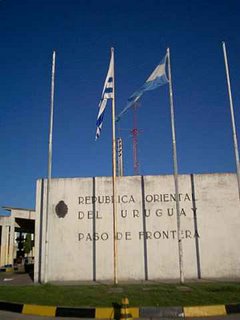 Paso de fronteira Uruguai/Argentina. É ainda de manhã cedo, por volta das 7 horas, estamos na cidade de Paysandu, no Uruguai. Estamos a poucos minutos de cruzar a fronteira e entrar em território argentino. Mas ainda falta os funcionários da aduana liberar o ônibus / Border Uruguay/Argentina. It´s still early in the morning, 7:00 am, we are in Paysandu, Uruguay, but we are about to cross the "paso de frontera" (borderline) in some minutes after the officials custom cleared our bus.
Paso de fronteira Uruguai/Argentina. É ainda de manhã cedo, por volta das 7 horas, estamos na cidade de Paysandu, no Uruguai. Estamos a poucos minutos de cruzar a fronteira e entrar em território argentino. Mas ainda falta os funcionários da aduana liberar o ônibus / Border Uruguay/Argentina. It´s still early in the morning, 7:00 am, we are in Paysandu, Uruguay, but we are about to cross the "paso de frontera" (borderline) in some minutes after the officials custom cleared our bus.
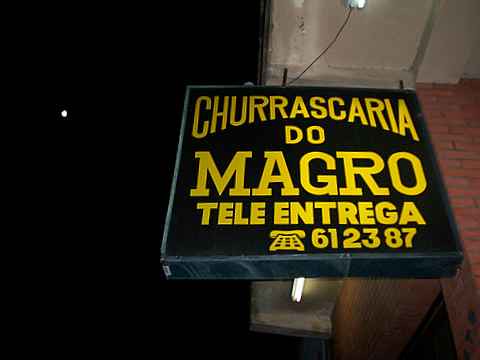 Dia 1º de novembro saímos de Rio Grande, RS às 20:30 e seguimos viagem via Pelotas, Arroio Grande, Jaguarão, Rio Branco, Mello, Paysandu, Gualeguaychu, Zarate e Buenos Aires. Tempo total de viagem: 16 horas. Na foto, está o único restaurante que nos acolheu em Jaguarão, já tarde da noite, por volta da meia-noite, para o jantar, última refeição ainda em terras brasileiras. Um saboroso churrasco. / November, 1st we leave Rio Grande, RS at 20:30 and our bus passed the cities of Pelotas, Arroio Grande, Jaguarão, Rio Branco, Mello, Paysandu, Gualeguaychu, Zarate and Buenos Aires. Total time: 16 hours. On the pic, it´s the only restaurant in Jaguarão that was still serving dinner in our last meal in Brazil. A delicious barbecue.
Dia 1º de novembro saímos de Rio Grande, RS às 20:30 e seguimos viagem via Pelotas, Arroio Grande, Jaguarão, Rio Branco, Mello, Paysandu, Gualeguaychu, Zarate e Buenos Aires. Tempo total de viagem: 16 horas. Na foto, está o único restaurante que nos acolheu em Jaguarão, já tarde da noite, por volta da meia-noite, para o jantar, última refeição ainda em terras brasileiras. Um saboroso churrasco. / November, 1st we leave Rio Grande, RS at 20:30 and our bus passed the cities of Pelotas, Arroio Grande, Jaguarão, Rio Branco, Mello, Paysandu, Gualeguaychu, Zarate and Buenos Aires. Total time: 16 hours. On the pic, it´s the only restaurant in Jaguarão that was still serving dinner in our last meal in Brazil. A delicious barbecue.

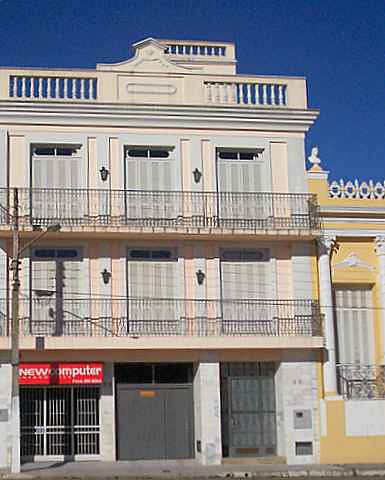 Outro prédio histórico de Jaguarão, no Rio Grande do Sul. À esquerda, embaixo há uma faixa vermelha que diz: 'new computer'. É uma loja de hard e software. Imagino que o dono original da construção, pelos idos do século XIX. nem pensou que a foto de sua casa iria correr o mundo desse jeito / Another historic building in Jaguarão, Rio Grande do Sul, Brazil. On left, below, there´s poster saying: 'new computer'. It´s a hardware and software shop. I wonder the old owner of this house in the 19st century never thought the picture of his house would run the world in this way.
Outro prédio histórico de Jaguarão, no Rio Grande do Sul. À esquerda, embaixo há uma faixa vermelha que diz: 'new computer'. É uma loja de hard e software. Imagino que o dono original da construção, pelos idos do século XIX. nem pensou que a foto de sua casa iria correr o mundo desse jeito / Another historic building in Jaguarão, Rio Grande do Sul, Brazil. On left, below, there´s poster saying: 'new computer'. It´s a hardware and software shop. I wonder the old owner of this house in the 19st century never thought the picture of his house would run the world in this way.
 A placa homenageia o Barão de Mauá, que dá o nome à ponte que separa o Brasil do Uruguai, construída em 1930. Barão de Mauá é natural de Arroio Grande, que fica a 50 km de Jaguarão./ This plaque pays a tribute to Barão de Mauá, former brazilian foreign minister, in 1930. The bridge was build in the same year.
A placa homenageia o Barão de Mauá, que dá o nome à ponte que separa o Brasil do Uruguai, construída em 1930. Barão de Mauá é natural de Arroio Grande, que fica a 50 km de Jaguarão./ This plaque pays a tribute to Barão de Mauá, former brazilian foreign minister, in 1930. The bridge was build in the same year.
 Eis o destino da maioria das pessoas que viajam a Rio Branco, no Uruguai: o freeshop. Esta loja fica no início da rua, logo que descemos da ponte, de onde tirei a foto. Mochileiro não é o tipo consumista, mas tem amigos e parentes que são... / This is the target of most of the travellers who goes to Rio Branco, Uruguay: the freeshop. This shop is located in the beggining of the main street, right after the bridge, where I took this shot.
Eis o destino da maioria das pessoas que viajam a Rio Branco, no Uruguai: o freeshop. Esta loja fica no início da rua, logo que descemos da ponte, de onde tirei a foto. Mochileiro não é o tipo consumista, mas tem amigos e parentes que são... / This is the target of most of the travellers who goes to Rio Branco, Uruguay: the freeshop. This shop is located in the beggining of the main street, right after the bridge, where I took this shot.
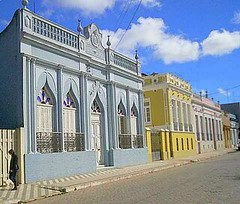
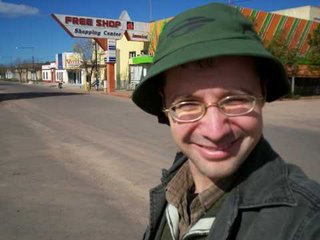 Brasil e Uruguai são separados por uma avenida.
Brasil e Uruguai são separados por uma avenida.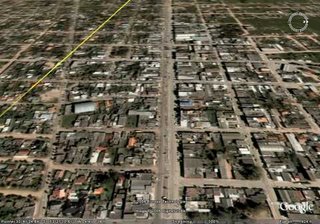 Perspectiva do Google Earth da fronteira do Brasil/Uruguai. Embora a linha amarela à esquerda seja a verdadeira demarcação da fronteira, fisicamente ela não existe. Pelo costume internacional, acabou ficando como faixa de fronteira a avenida que você vê no centro da foto. Do lado esquerdo da avenida está a cidade do Chuy, lado uruguaio. Do lado direito, está a cidade de Chui, no Brasil. É nesta avenida, chamada Avenida Brasil, que se desenvolve o comércio da cidade através de vários free-shops que pode-se comprar artigos eletrônicos, eletrodomésticos, perfumes, bebidas a preços em conta, dependendo do câmbio. Atualmente, com o real forte, milhares de brasileiros cruzam a fronteira, ou melhor, a avenida, para fazer compras. Uma curiosidade: a avenida é composta de duas pistas independentes uma da outra, isto é, em ambos os lados há dois sentidos, o que pode confundir o turista desavisado (foi o meu caso...). / Google Earth perspective of the Brazil/Uruguay border. Although the yellow line in the left is the real frontier, phisically it doesn´t exist. International customs decided the real border is the avenue that you see in the center of the picture. On the left side, it is located the city of Chuy, Uruguay. On the right side, it is located the city of Chui, Brazil. It´s on this avenue where tourists go shopping perfumes, colognes, drinks, household appliances, electronic devices at cheaper prices. Cars in the avenue runs at both directions in the both roads, it can be confusing for the tourist (it happened with me...)
Perspectiva do Google Earth da fronteira do Brasil/Uruguai. Embora a linha amarela à esquerda seja a verdadeira demarcação da fronteira, fisicamente ela não existe. Pelo costume internacional, acabou ficando como faixa de fronteira a avenida que você vê no centro da foto. Do lado esquerdo da avenida está a cidade do Chuy, lado uruguaio. Do lado direito, está a cidade de Chui, no Brasil. É nesta avenida, chamada Avenida Brasil, que se desenvolve o comércio da cidade através de vários free-shops que pode-se comprar artigos eletrônicos, eletrodomésticos, perfumes, bebidas a preços em conta, dependendo do câmbio. Atualmente, com o real forte, milhares de brasileiros cruzam a fronteira, ou melhor, a avenida, para fazer compras. Uma curiosidade: a avenida é composta de duas pistas independentes uma da outra, isto é, em ambos os lados há dois sentidos, o que pode confundir o turista desavisado (foi o meu caso...). / Google Earth perspective of the Brazil/Uruguay border. Although the yellow line in the left is the real frontier, phisically it doesn´t exist. International customs decided the real border is the avenue that you see in the center of the picture. On the left side, it is located the city of Chuy, Uruguay. On the right side, it is located the city of Chui, Brazil. It´s on this avenue where tourists go shopping perfumes, colognes, drinks, household appliances, electronic devices at cheaper prices. Cars in the avenue runs at both directions in the both roads, it can be confusing for the tourist (it happened with me...)
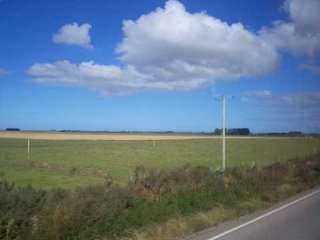 Para chegar ao Chuy (ou Chui, do lado brasileiro) eu peguei o ônibus em Pelotas, às 9:30. A viagem leva cerca de 4 horas. Não espere uma paisagem muito fascinante na viagem, ela é monótona a maior parte do tempo, trata-se de uma paisagem extremamente plana. Na maioria do tempo, você verá fazendas de arroz, como pode-se ver na foto. No meio do caminho, existe a Reserva Ecológica do Taim, mas em virtude da uma severa seca, onde era o banhado que via-se a fauna, há agora apenas campo. / To go to Chuy (or Chui, in the brazilian side of the border), I get the bus in Pelotas at 9:30. The trip takes around 4 hours. Don´t expect a exciting views during the trip, since it is a dull landscape in a extremely plain terrain. Most of the time you will see rice farms, as you see in the picture. In the middle of the way, there is an Ecological Reserve, called "Taim", but due to a severe drought were shoud be swamps, there just lawn.
Para chegar ao Chuy (ou Chui, do lado brasileiro) eu peguei o ônibus em Pelotas, às 9:30. A viagem leva cerca de 4 horas. Não espere uma paisagem muito fascinante na viagem, ela é monótona a maior parte do tempo, trata-se de uma paisagem extremamente plana. Na maioria do tempo, você verá fazendas de arroz, como pode-se ver na foto. No meio do caminho, existe a Reserva Ecológica do Taim, mas em virtude da uma severa seca, onde era o banhado que via-se a fauna, há agora apenas campo. / To go to Chuy (or Chui, in the brazilian side of the border), I get the bus in Pelotas at 9:30. The trip takes around 4 hours. Don´t expect a exciting views during the trip, since it is a dull landscape in a extremely plain terrain. Most of the time you will see rice farms, as you see in the picture. In the middle of the way, there is an Ecological Reserve, called "Taim", but due to a severe drought were shoud be swamps, there just lawn.
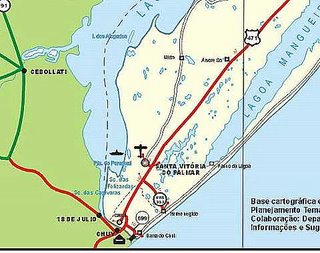 Na próxima série de posts vou mostrar algumas fotos de uma rápida trip que fiz ao Chuy, no Uruguai. No lado brasileiro, fica a cidade homônima: Chui (com 'i'). É o ponto mais meridional do país, daí a famosa expressão: "do Oiapoque ao Chui". / In the next posts I will show some pics from a quick trip to Chuy, Uruguay. In the brazilian side of the border there is a city with
Na próxima série de posts vou mostrar algumas fotos de uma rápida trip que fiz ao Chuy, no Uruguai. No lado brasileiro, fica a cidade homônima: Chui (com 'i'). É o ponto mais meridional do país, daí a famosa expressão: "do Oiapoque ao Chui". / In the next posts I will show some pics from a quick trip to Chuy, Uruguay. In the brazilian side of the border there is a city with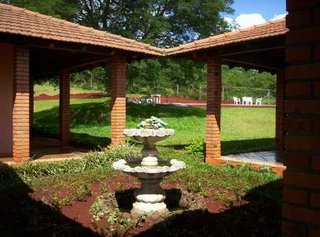 Fiquei na Pousada das Missões , é um lugar extremamente agradável, tranqüilo, bonito e o pessoal é muito atencioso. Toda decoração é inspirada na arte missioneira: a fonte, os quartos, até mesmo a caixa d´água foi construída seguindo o modelo do antigo observatório que existia na aldeia. É possível ver a foto do satélite no post anterior, ela está à esquerda. Como se vê, ela fica perto das ruínas. I stayed at Pousada das Missões, it´s a very pleasant, peaceful and beautiful place. Every detail was inspired in the missionary art: the font, the rooms even the water reservoir was inspired in the old observatory that was build in the village. It´s possible to see the hostel in the last post, on the left of the picture. The hostel is near from the ruins.
Fiquei na Pousada das Missões , é um lugar extremamente agradável, tranqüilo, bonito e o pessoal é muito atencioso. Toda decoração é inspirada na arte missioneira: a fonte, os quartos, até mesmo a caixa d´água foi construída seguindo o modelo do antigo observatório que existia na aldeia. É possível ver a foto do satélite no post anterior, ela está à esquerda. Como se vê, ela fica perto das ruínas. I stayed at Pousada das Missões, it´s a very pleasant, peaceful and beautiful place. Every detail was inspired in the missionary art: the font, the rooms even the water reservoir was inspired in the old observatory that was build in the village. It´s possible to see the hostel in the last post, on the left of the picture. The hostel is near from the ruins.
 Visão de satélite do sítio arqueológico da Igreja de São Miguel do Arcanjo. À esquerda, está a Pousada das Missões, onde eu me hospedei. À direita, está a igreja. Acima da igreja, está o Museu das Missões. Satellite view of the archeological site. On the left, there is the Pousada das Missões Hostel, where I stay. On the right side, you can see the ruins of the church, above the church, you can see the museum.
Visão de satélite do sítio arqueológico da Igreja de São Miguel do Arcanjo. À esquerda, está a Pousada das Missões, onde eu me hospedei. À direita, está a igreja. Acima da igreja, está o Museu das Missões. Satellite view of the archeological site. On the left, there is the Pousada das Missões Hostel, where I stay. On the right side, you can see the ruins of the church, above the church, you can see the museum. Dica para quem está em forma: alugue uma bicicleta e pedale na RS-536 até o trevo da BR-385! São 32 km, ida e volta, com muitas descidas e subidas. Os freios da bicicleta têm que estar em boas condições, algumas descidas são muito longas e descer sem acionar os freios é muito perigoso. Foi o melhor passeio de bicleta da minha vida. Tip if you are in good shape: rent a bike and ride in the road called RS-536 until it crosses another road the BR-385! It´s 32km the round trip, there´s lots of way up and way down. Brakes of the bike must be in perfect conditions, since some way down are very long and it´s dangerous to ride without using the brakes. It was my best bike ride in my life.
Dica para quem está em forma: alugue uma bicicleta e pedale na RS-536 até o trevo da BR-385! São 32 km, ida e volta, com muitas descidas e subidas. Os freios da bicicleta têm que estar em boas condições, algumas descidas são muito longas e descer sem acionar os freios é muito perigoso. Foi o melhor passeio de bicleta da minha vida. Tip if you are in good shape: rent a bike and ride in the road called RS-536 until it crosses another road the BR-385! It´s 32km the round trip, there´s lots of way up and way down. Brakes of the bike must be in perfect conditions, since some way down are very long and it´s dangerous to ride without using the brakes. It was my best bike ride in my life.
 Fora do sítio arqueológico da Igreja de São Miguel do Arcanjo, em São Miguel das Missões, foi descoberta uma fonte construída pelos guaranis, que eram construídas na periferia das cidades. Fica umas 5 quadras do sítio. É um passeio interessante de bike! There is a font ouside the site where is located the São Miguel do Arcanjo Church. The font is around 5 blocks away. Fonts used to be constructed in the outskirts of the village. It´s a interesting bike trip!
Fora do sítio arqueológico da Igreja de São Miguel do Arcanjo, em São Miguel das Missões, foi descoberta uma fonte construída pelos guaranis, que eram construídas na periferia das cidades. Fica umas 5 quadras do sítio. É um passeio interessante de bike! There is a font ouside the site where is located the São Miguel do Arcanjo Church. The font is around 5 blocks away. Fonts used to be constructed in the outskirts of the village. It´s a interesting bike trip!
 Dentro do sítio, há um museu projetado por Lúcio Costa e construído em 1940. Há cerca de 100 estátuas confeccionadas em estilo barroco pelos guaranis. Algumas estátuas tem mais de dois metros de altura. Na foto, alguns exemplos das imagens. There´s a museum inside the archeological site build in 1940, project by Lucio Costa. In the museum, there´s 100 statues build by indians. Some of them has 2 metres of height. Some examples of these statues in the picture.
Dentro do sítio, há um museu projetado por Lúcio Costa e construído em 1940. Há cerca de 100 estátuas confeccionadas em estilo barroco pelos guaranis. Algumas estátuas tem mais de dois metros de altura. Na foto, alguns exemplos das imagens. There´s a museum inside the archeological site build in 1940, project by Lucio Costa. In the museum, there´s 100 statues build by indians. Some of them has 2 metres of height. Some examples of these statues in the picture.
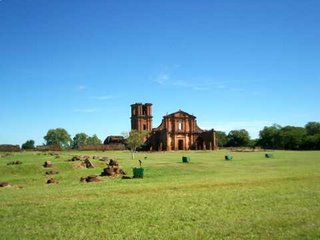 Visão da Igreja de São Miguel do Arcanjo à distância. Tirei esta foto onde fica a arquibancada em que se assiste ao espetáculo chamado "Som e Luz", o qual é uma representação eletrônica da história das Missões na voz dos artistas da Rede Globo. A voz de Fernanda Montenegro é facilmente reconhecível! O show ocorre todas as noites, de domingo a domingo. Distant view of the São Miguel do Arcanjo Church. I took this shot in the bleachers. It´s used to assist the daily show at night wich tells the history of the Missions in the electronic voice of famous brazilain artists.
Visão da Igreja de São Miguel do Arcanjo à distância. Tirei esta foto onde fica a arquibancada em que se assiste ao espetáculo chamado "Som e Luz", o qual é uma representação eletrônica da história das Missões na voz dos artistas da Rede Globo. A voz de Fernanda Montenegro é facilmente reconhecível! O show ocorre todas as noites, de domingo a domingo. Distant view of the São Miguel do Arcanjo Church. I took this shot in the bleachers. It´s used to assist the daily show at night wich tells the history of the Missions in the electronic voice of famous brazilain artists.
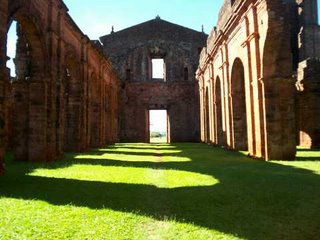 Vista dos fundos do interior da Igreja de São Miguel do Arcanjo. Desta vez, as sombras proporcionaram uma bela visão simétrica na fotografia. O local onde eu estava quando tirei a foto ficava o altar da igreja. Back inside view of the São Miguel do Arcanjo Church. This time the shadows allow a beautiful and simetric view of the picture. The place where I shot this picture was the altar of the chuch.
Vista dos fundos do interior da Igreja de São Miguel do Arcanjo. Desta vez, as sombras proporcionaram uma bela visão simétrica na fotografia. O local onde eu estava quando tirei a foto ficava o altar da igreja. Back inside view of the São Miguel do Arcanjo Church. This time the shadows allow a beautiful and simetric view of the picture. The place where I shot this picture was the altar of the chuch.
 Vista da parede lateral da Igreja de São Miguel do Arcanjo. Neste gramado de onde tirei a foto ficava o cemitério. Nos seus fundos, que não aparece na foto, há um limoeiro. Outside view of the São Miguel do Arcanjo Church. In this lawn where I took this picture was the cemetery in the past. In the back of the lawn there is a lemmon plantation.
Vista da parede lateral da Igreja de São Miguel do Arcanjo. Neste gramado de onde tirei a foto ficava o cemitério. Nos seus fundos, que não aparece na foto, há um limoeiro. Outside view of the São Miguel do Arcanjo Church. In this lawn where I took this picture was the cemetery in the past. In the back of the lawn there is a lemmon plantation.